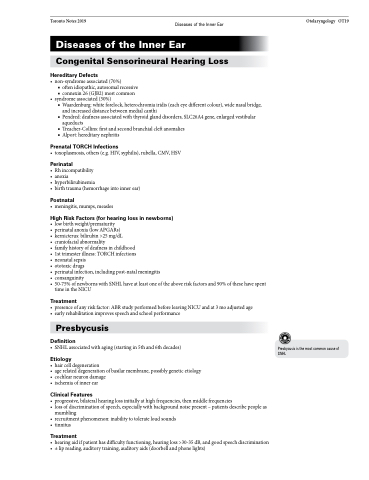Page 1005 - TNFlipTest
P. 1005
Toronto Notes 2019 Diseases of the Inner Ear Otolaryngology OT19 Diseases of the Inner Ear
Congenital Sensorineural Hearing Loss
Hereditary Defects
• non-syndromeassociated(70%)
■ often idiopathic, autosomal recessive ■ connexin 26 (GJB2) most common
• syndromeassociated(30%)
■ Waardenburg: white forelock, heterochromia iridis (each eye different colour), wide nasal bridge,
and increased distance between medial canthi
■ Pendred: deafness associated with thyroid gland disorders, SLC26A4 gene, enlarged vestibular
aqueducts
■ Treacher-Collins: first and second branchial cleft anomalies
■ Alport: hereditary nephritis
Prenatal TORCH Infections
• toxoplasmosis,others(e.g.HIV,syphilis),rubella,CMV,HSV
Perinatal
• Rhincompatibility
• anoxia
• hyperbilirubinemia
• birthtrauma(hemorrhageintoinnerear)
Postnatal
• meningitis, mumps, measles
High Risk Factors (for hearing loss in newborns)
• lowbirthweight/prematurity
• perinatalanoxia(lowAPGARs)
• kernicterus:bilirubin>25mg/dL
• craniofacialabnormality
• familyhistoryofdeafnessinchildhood
• 1sttrimesterillness:TORCHinfections
• neonatalsepsis
• ototoxicdrugs
• perinatalinfection,includingpost-natalmeningitis
• consanguinity
• 50-75%ofnewbornswithSNHLhaveatleastoneoftheaboveriskfactorsand90%ofthesehavespent
time in the NICU
Treatment
• presenceofanyriskfactor:ABRstudyperformedbeforeleavingNICUandat3moadjustedage • earlyrehabilitationimprovesspeechandschoolperformance
Presbycusis
Definition
• SNHLassociatedwithaging(startingin5thand6thdecades)
Etiology
• haircelldegeneration
• agerelateddegenerationofbasilarmembrane,possiblygeneticetiology • cochlearneurondamage
• ischemiaofinnerear
Clinical Features
• progressive,bilateralhearinglossinitiallyathighfrequencies,thenmiddlefrequencies
• lossofdiscriminationofspeech,especiallywithbackgroundnoisepresent–patientsdescribepeopleas
mumbling
• recruitmentphenomenon:inabilitytotolerateloudsounds
• tinnitus
Treatment
• hearingaidifpatienthasdifficultyfunctioning,hearingloss>30-35dB,andgoodspeechdiscrimination • ±lipreading,auditorytraining,auditoryaids(doorbellandphonelights)
Presbycusis is the most common cause of SNHL


